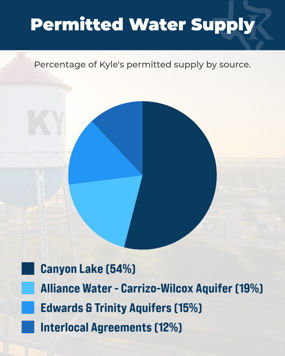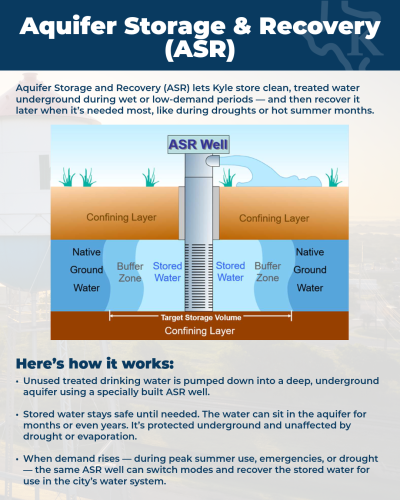About Kyle Water


As the City of Kyle continues to grow, so does the demand for a dependable and sustainable water supply. To meet this challenge, the city has developed a diversified water portfolio — a combination of water sources designed to serve both current residents and future generations.
Surface Water from Canyon Reservoir
Approximately 54% of Kyle’s current total permitted water supply originates from Canyon Reservoir at Canyon Lake. This surface water is provided through a contractual agreement with the Guadalupe-Blanco River Authority (GBRA), which holds the rights to manage this resource under the authority of the Texas Commission on Environmental Quality (TCEQ). Once treated at the San Marcos Surface Water Treatment Plant, this water is delivered to the city and stored in municipal storage tanks.
Each year, Kyle purchases over one billion gallons of water from Canyon Reservoir. While the reservoir’s total capacity is approximately 123 billion gallons, its current level is significantly reduced due to ongoing drought conditions. GBRA imposes water usage limitations based on their drought stages, which are directly influenced by the reservoir's water level.
View GBRA’s current drought stage
Ground Water from Aquifers
An additional 15% of Kyle’s current total permitted water supply comes from groundwater wells that draw from the Edwards and Barton Springs Trinity Aquifers. These sources are regulated by two Groundwater Conservation Districts. The City operates five permitted wells — four under the Edwards Aquifer Authority (EAA) and one under the Barton Springs Edwards Aquifer Conservation District (BSEACD).
These wells are capable of producing hundreds of millions of gallons annually; however, Edwards and Trinity Aquifers pumping is subject to strict limits that vary with the Groundwater Conservation Districts respective drought stages. These stages are determined by aquifer levels and spring flows.
View EAA’s current drought stage
View BSEACD‘s current drought stage
Expansion through Alliance Water
To ensure long-term sustainability, the City of Kyle is expanding its water supply through a partnership with Alliance Water (ARWA). ARWA is a regional partnership focused on developing sustainable water supplies from the Carrizo-Wilcox Aquifer, a major groundwater source. This partnership enables cities like Kyle to access a long-term, drought-resilient water supply. Currently ARWA makes up 19% (with ARWA Phase 1B Operational) of Kyle’s total permitted water supply but will increase to 56% (with ARWA Phase 2 Operational) upon completion of Phase 2, slated for 2032.
Learn more about the City’s partnership with Alliance Water.
Interlocal Agreements
The remaining 12% of Kyle’s current total permitted water supply is provided through interlocal agreements with the City of San Marcos and the Green Valley Special Utility District, offering an additional layer of resilience to the overall supply portfolio.
City of Kyle is also working with Alliance Water partners and the GBRA to discuss near-term water agreements for additional supply from portions of partners’ share of Phases 1B and 1C/D water supply, which could bring on an approximately 1.0 Million Gallons Per Day (MGD) in 2026; increasing to 2.0 MGDs from 2027 to 2031.
Alliance Water Phases

Total Permitted vs Firm Water Supplies

Definitions:
- Permitted Supply: Total permitted water supply available to City in a calendar year.
- Firm Supply: Total permitted water supply available to the City in a calendar year with maximum drought reductions in place.
- Interruptible Supply: Water supply that a water authority can curtail during drought conditions.
This graphic compares the City’s total permitted water supply with its firm supply projections through the year 2032, measured in millions of gallons per day (MGD). Permitted supply (dark blue) represents the maximum water volume the City is allowed to use in a given year. Firm supply (medium blue) reflects the amount available under maximum drought restrictions, ensuring a reliable source even in dry conditions. The difference between the two is the interruptible supply (gray), which can be reduced or eliminated by the water authority during droughts.
In 2025, the City’s permitted supply is 9.03 MGD, with 6.47 MGD as firm supply and 2.56 MGD as interruptible. By 2027, these numbers rise to 11.4 MGD permitted, 9.04 MGD firm, and 2.36 MGD interruptible. In 2032, the City is projected to have 16.44 MGD permitted, 14.08 MGD firm, and 2.36 MGD interruptible, illustrating significant long-term increases in both permitted and drought-reliable water supplies.
Water Supply Planning Strategies

As part of its long-term planning efforts, the City of Kyle is actively exploring innovative strategies to enhance water reliability and sustainability. These initiatives are designed to complement the City's existing water portfolio and support future growth.
Key Strategies Under Evaluation Include:
- Aquifer Storage and Recovery (ASR) will let Kyle pump surplus treated water into the Trinity Aquifer during low-demand months and recover it during drought or summer peaks; field testing starts in 2026, with about 1 MGD online by 2030 and room to double that later.
- The city will join GBRA’s WaterSECURE program, which is expected to deliver roughly 4 MGD of treated surface water from a new off-channel reservoir by 2034.
- Finally, Kyle plans to build an advanced potable-reuse facility that will turn highly treated wastewater into a new drinking-water source—about 3 MGD by 2036, expandable to 6 MGD by 2041.
Together these projects create a diversified, drought-resilient supply that will keep pace with Kyle’s rapid growth.
Kyle’s Water Infrastructure

All of Kyle’s water is stored and moved around the city through our water system that is made up of 8 elevated storage tanks, 12 ground storage tanks, 2 pressure tanks, 5 groundwater wells, 4 water take points , 1 pump station, approximately 226 miles of water main lines, over 5,000 fire hydrants, and more than 19,000 service connections, with new projects coming online all the time.
Who Provides Your Water in Kyle?
The City of Kyle’s Certificate of Convenience and Necessity (CCN) — the official area where the City is authorized to provide water and wastewater services — does not exactly match the city limits or its extraterritorial jurisdiction (ETJ). The same goes for the City's wastewater CCN.
As a retail public utility, the City of Kyle has the exclusive right to provide water and wastewater services within specific areas. However, other providers also operate within Kyle, which means water, wastewater service boundaries, and city boundaries don’t always align. Because of this, some neighborhoods may be served by the City of Kyle, while others nearby may fall under the service area of a different utility. For example, one neighborhood may follow City of Kyle drought restrictions, while another close by may not.
To see who provides your water and wastewater service, use our interactive map.
Water Regulation in Texas
Water is one of Texas’s most valuable resources — and it’s regulated in several ways depending on whether it’s above or below ground.
Surface Water: Owned by the State
In Texas, all surface water—like lakes, rivers, and streams—is owned by the State and held in trust for the public. The Texas Commission on Environmental Quality (TCEQ) is the state agency in charge of managing this resource.
TCEQ grants water rights to groups such as municipalities, river authorities, and ranchers. These rights allow them to use specific amounts of surface water. Water rights holders can also sell surface water through contracts. These contracts can include curtailments, or usage limits, that kick in during drought conditions.
For tips on how to help protect our lakes, rivers, and streams, visit KyleStormwater.com.
Groundwater: Owned by the Landowner
Groundwater—water stored underground in aquifers—is regulated under a different principle called the Rule of Capture, often nicknamed “the law of the biggest pump.” Under this rule, if you own the land, you own the water beneath it. You’re allowed to pump as much as you want, even if it affects your neighbor. While this gives landowners flexibility, it can also lead to overuse. That’s where Groundwater Conservation Districts (GCDs) come in.
Groundwater Conservation Districts (GCDs)
To protect aquifers and ensure long-term sustainability, GCDs have been established in many parts of the state. These districts set limits on how much water can be pumped from the ground, particularly in areas with sensitive ecosystems or endangered species.
Not all of Texas is regulated by a GCD, but here in Hays County, because of the unique history of Barton Springs and the Edwards Aquifer, there are four GCDs, two of which overlap. We care about conservation in Central Texas, and this means that Edwards Aquifer groundwater is very protected, and folks interested in pumping groundwater from a well in this area are heavily regulated. To operate a well within a GCD, the well-owner must apply for a groundwater well permit from the GCD, which sets restrictions on how much water can be extracted. The groundwater well permit also limits, or curtails, the amount of water that can be pumped if the GCD enters into a drought stage.
Conservation and Responsible Stewardship
Our commitment to responsible water planning doesn't stop here. As our community continues to grow, so does the need for careful, forward-thinking management of this essential resource. Protecting Kyle’s water supply is not a one-time project—it’s an ongoing effort that requires all of us to play a part.
Every drop counts. Whether it’s fixing a leaky faucet, watering your lawn wisely, or staying informed about drought stages and watering schedules, small actions at home can make a big difference citywide.
Join us in preserving our water future. Explore conservation tips, learn about current water restrictions, and discover programs that can help you save water—and money—today.
View the City’s current drought restrictions
Learn more about the City’s Water Conservation Rebate Programs
Kyle’s Growth and Water Use Over Time

City of Kyle Weather Station
Higher than normal temperatures and low amounts of rainfall have a tremendous effect on the amount of water produced in Kyle. We’ve added a live weather widget from our Weather Station at the Public Safety Center so you can track current and historical rainfall, temperatures, and wind speeds right here in Kyle. Local conditions have a direct impact on water use and drought rules, so this real-time data lets you see exactly how much rain has fallen in Kyle—and helps our community plan and conserve more effectively.
Related Links
Sign up for our Newsletter
Stay up to date on the city's activities, events, programs and operations by subscribing to our eNewsletters.




